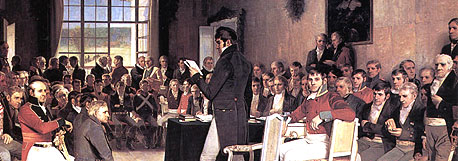ADVERTISEMENT
|
|
|
Norway Travel & Tourism Guide
Norway History - Union with Sweden (19th Century)
NextGen Day offers travel tips and information for top travel places and best destinations in Africa, Asia, Australia, Europe, Middle East and United States of America. We feature Australia links, Australia resources and large selection of Australia budget airlines, Australia chartered planes, Australia sea cruises, Australia ferries, Australia travel agencies, Australia land transports and Australia attractions including Australia beaches, Australia medical tourism, Australia retirement homes, Australia historical and Australia pilgrimage tours.
 The 1814 constitutional assembly, painted by Oscar Wergeland
The 1814 constitutional assembly, painted by Oscar Wergeland
After Denmark–Norway was attacked by Great Britain, it entered into an alliance with Napoleon, with the war leading to dire conditions and mass starvation in 1812. As the Danish kingdom found itself on the losing side in 1814 it was forced to cede Norway to the kingdom of Sweden, while the old Norwegian provinces of Iceland, Greenland and the Faroe Islands remained with the Danish crown. Norway took this opportunity to declare independence, adopted a constitution based on American and French models, and elected the Danish crown prince Christian Fredrik as king on 17 May 1814. This caused the Norwegian-Swedish War to break out between Sweden and Norway but as Sweden's military was not strong enough to defeat the Norwegian forces outright and Norway's treasury was not large enough to support a protracted war, and as British and Russian navies blockaded the Norwegian coast, Norway agreed to enter a personal union with Sweden. Under this arrangement, Norway kept its liberal constitution and independent institutions, except for the foreign service.
This period also saw the rise of the Norwegian romantic nationalism, as Norwegians sought to define and express a distinct national character. The movement covered all branches of culture, including literature (Henrik Wergeland, Bjørnstjerne Bjørnson, Peter Christen Asbjørnsen, Jørgen Moe, Henrik Ibsen), painting (Hans Gude, Edvard Munch, Adolph Tidemand), music (Edvard Grieg), and even language policy, where attempts to define a native written language for Norway led to today's two official written forms for Norwegian: Bokmål and Nynorsk.
Source: Wikipedia Encyclopedia
Norway Hotels
<1> <2> <3> <4> <5> <6> <7> <8> |

